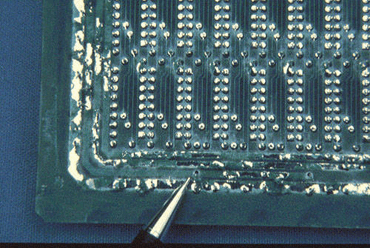Wave Soldering Defects
Lifted Resist on a Printed Circuit Board
Figure 1 shows a very obvious example of resist lifting from the surface of the board after soldering. Quite simply this is due to incorrect specification of the printed board. Tin/lead should not be used under resist on professional circuit boards. As the tin/lead moves into a liquid phase it expands and may cause loss of adhesion between the solder and the resist. If the resist is brittle or thin it will separate as shown in Figure 1. It is possible to use tin/lead if the thickness of the coating is less than 3-5µm as there will be very little movement during wave or reflow soldering.

Figure 1: The resist lifting here is due to incorrect specification of the PCB.




